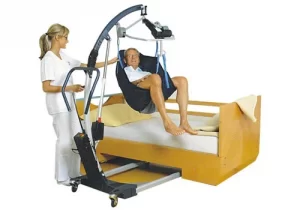 Patient lifting equipment refers to a range of devices and machinery used to assist with the lifting and transfer of patients with mobility limitations. These devices are commonly used in hospitals, nursing homes, and other healthcare settings, as well as in home care situations where patients require assistance with daily activities.
Patient lifting equipment refers to a range of devices and machinery used to assist with the lifting and transfer of patients with mobility limitations. These devices are commonly used in hospitals, nursing homes, and other healthcare settings, as well as in home care situations where patients require assistance with daily activities.
Get Sample PDF Report with Graphs and Figures Here
What are the common types of patient lifting equipment?
- Patient lifts: These are electric or hydraulic lifts that are used to lift and transfer patients from a bed or wheelchair to another surface, such as a commode, shower chair, or exam table.
- Slings: Slings are used in conjunction with patient lifts to support the patient’s body during the transfer. There are different types of slings, such as full-body slings, which provide support for the entire body, or divided-leg slings, which are designed for patients with limited mobility in their legs.
- Transfer boards: These are flat boards that are used to slide patients from one surface to another, such as from a bed to a wheelchair or from a wheelchair to a car.
- Stairlifts: These are devices that are attached to a staircase and are used to lift patients up and down the stairs.
- Bath lifts: These are devices that lower a patient into a bathtub or shower and then lift them back out again.
Patient lifting equipment is designed to reduce the risk of injury to both patients and healthcare workers. It is important to ensure that the equipment is properly maintained and used correctly to ensure the safety of everyone involved in the lifting and transfer process.
There are generally four key steps to safely lifting patients:
- Assess: Before lifting or transferring a patient, it is important to assess the patient’s mobility, weight, and any specific needs they may have. Assessing the patient will help determine the appropriate lifting equipment to use, the number of staff needed for the lift, and the best lifting technique to use.
- Plan: Once the patient has been assessed, a plan should be developed for the lift. This should include identifying the appropriate lifting equipment, selecting the best lifting technique, and ensuring that there are enough staff members available to safely perform the lift.
- Position: Proper positioning is essential for safe patient lifting. Patients should be positioned as close to the lifting equipment as possible, and their body should be properly aligned to ensure a safe lift. Staff members should also position themselves properly, ensuring that they have a stable base and can maintain good posture throughout the lift.
- Lift: When lifting the patient, it is important to use the proper lifting technique to avoid injury. This may involve using the patient lifting equipment, such as a patient lift or transfer board, and making sure that the lift is smooth and controlled. Staff members should communicate throughout the lift to ensure that everyone is working together and that the lift is performed safely and smoothly.
By following these four steps, healthcare workers can help ensure that patients are lifted and transferred safely, reducing the risk of injury to both the patient and staff members.
Assisting a patient with lifting will depend on the patient’s level of mobility and their specific needs. However, there are some general steps that can be followed to help a patient with lifting:
- Assess the patient’s mobility: Before helping a patient to lift, it is important to assess their mobility to determine the level of assistance they require. If the patient is able to stand and walk on their own, they may only need minimal assistance, such as support or guidance. If the patient has limited mobility, they may require more extensive assistance.
- Choose the right lifting equipment: Depending on the patient’s needs, lifting equipment may be required. This may include items such as a transfer board, patient lift, or other devices that are designed to assist with lifting and transferring patients.
- Communicate with the patient: Before lifting, communicate with the patient to ensure that they understand what is happening and how they can assist with the lift. Let the patient know what you are doing and how they can help, such as by holding onto handles or placing their feet in a certain position.
- Position the patient correctly: Proper positioning is essential for safe patient lifting. Position the patient as close to the lifting equipment as possible and make sure that they are properly aligned. Staff members should also position themselves properly, ensuring that they have a stable base and can maintain good posture throughout the lift.
- Lift with proper technique: When lifting the patient, it is important to use the proper lifting technique to avoid injury. This may involve using the lifting equipment or making sure that the lift is smooth and controlled. Staff members should communicate throughout the lift to ensure that everyone is working together and that the lift is performed safely and smoothly.
By following these steps, healthcare workers can help ensure that patients are lifted and transferred safely, reducing the risk of injury to both the patient and staff members.

